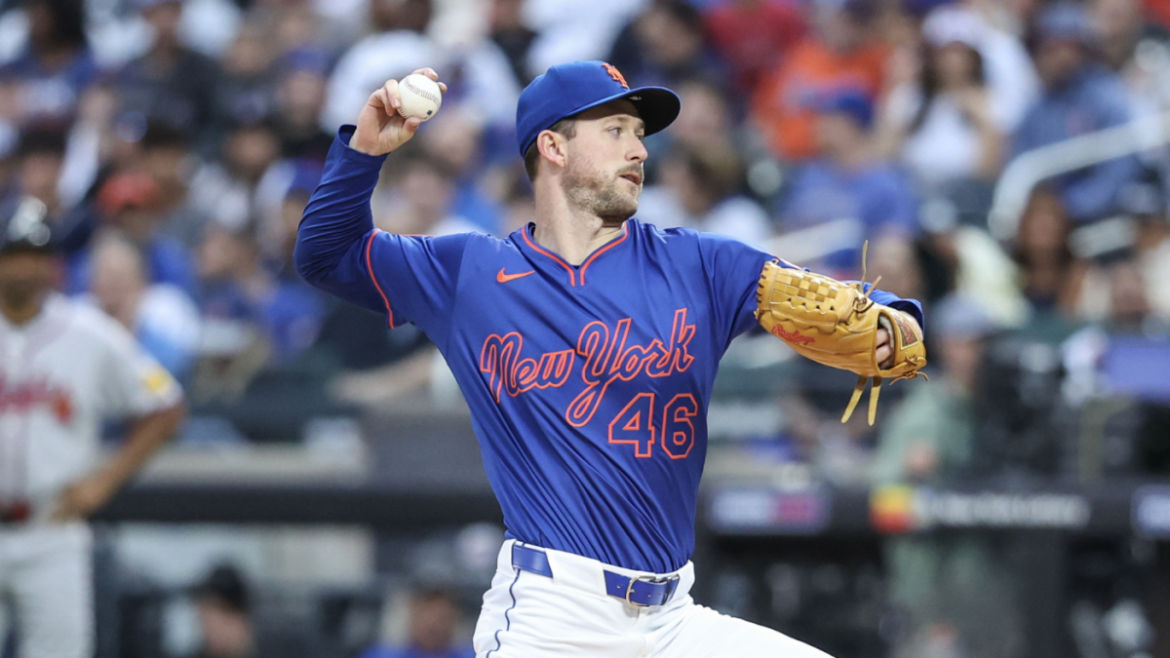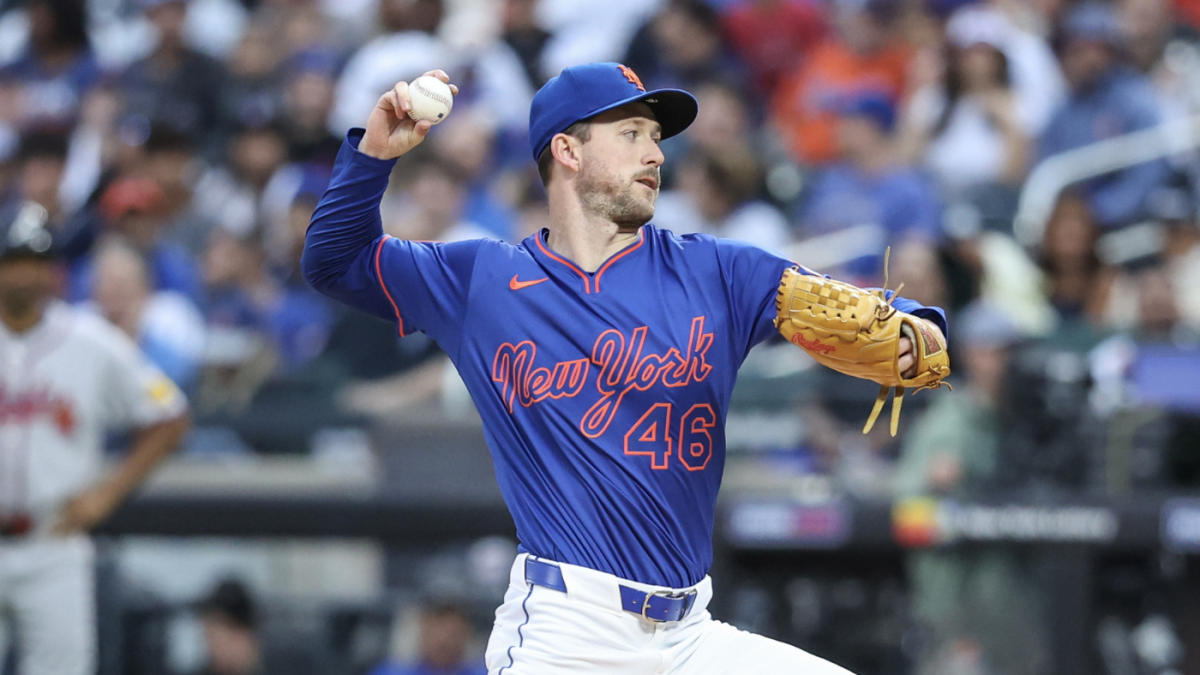The Mets’ recent victory over the Braves was overshadowed by a grim moment in the third inning when right-hander Griffin Canning suffered a concerning leg injury. The team’s climb to first place in the National League East should have been a cause for celebration, but instead, the clubhouse mood turned somber as Canning was helped off the field with a visibly painful injury. The incident has raised serious concerns about the Mets’ pitching depth and the potential long-term impact on their season.
The Incident: A Routine Play Turned Disastrous
Canning’s injury occurred during a routine play in the top of the third inning. Braves outfielder Eli White was on second base when Nick Allen hit a grounder to shortstop Francisco Lindor. As Canning attempted to cover first base, his left foot appeared to plant awkwardly at the edge of the mound. There was no dramatic collision or diving stop—just an awkward landing and an immediate reaction of pain. Trainers rushed to his side, and Canning struggled to put any weight on his left foot before being escorted off the field with support under each arm.
The Mets initially described the injury as a left ankle issue, but speculation quickly turned to a potential Achilles tendon injury—a diagnosis that has a notorious reputation for derailing careers and requiring lengthy recoveries. Mets manager Carlos Mendoza and TV analyst Ron Darling both hinted at the possibility of an Achilles injury, adding to the growing concern among fans and teammates.
Canning’s Immediate Impact: A Season on a Knife’s Edge
Before his injury, Canning was pitching exceptionally well, allowing just one hit and striking out three in 2/3 scoreless innings. His performance was a crucial contribution to a Mets rotation that has already dealt with several injuries. With pitchers like Frankie Montas and Sean Manaea working their way back from the injured list, the Mets could ill afford to lose another starter.
The loss of Canning has significant implications beyond just the immediate impact on the rotation. Pitching injuries create a ripple effect across the clubhouse, forcing relief pitchers to shoulder extra innings and potentially rushing younger arms into the major leagues before they are ready. This can lead to a domino effect of further injuries and reduced effectiveness, making it even more challenging for the Mets to maintain their early-season momentum.
Fear of the Achilles: What’s at Stake
Achilles tendon injuries are among the most serious for professional athletes, particularly pitchers. While an X-ray may rule out fractures, the Mets quickly scheduled advanced imaging, likely an MRI, to assess the condition of Canning’s tendon. A torn Achilles typically requires season-ending surgery followed by months of rehabilitation. Even after recovery, returning to pre-injury performance is far from guaranteed.
For pitchers, the explosion off the mound and the transfer of energy begin with the feet and drive through the legs. An Achilles tear could sap velocity, disrupt mechanics, and force changes to a player’s approach. This uncertainty adds another layer of concern for the Mets, who were already navigating a challenging pitching landscape.
Pitching Depth: The Mets’ Shifting Landscape
At the start of the season, Canning was an unexpected but welcome addition to the Mets’ rotation, providing stability when other starters faltered or landed on the injured list. Manager Carlos Mendoza leaned on Canning more heavily than anticipated, making his injury even more devastating. With Canning out, the Mets face immediate logistical and strategic concerns.
The bullpen will now have to absorb more innings, as evidenced by the quick summoning of Austin Warren in relief after Canning’s exit. The Mets may also consider promoting a pitcher from Triple-A, though this comes with risks, as younger pitchers may not be ready for the pressure of the major leagues. Frankie Montas, recently returned from the injured list, and Sean Manaea, working his way back, become even more vital to the team’s success. Kodai Senga, another key starter, will likely have to anchor the staff, with increased pressure on pitchers like Jose Butto and Luis Severino to pitch deeper into games.
The Psychological Ripple
Injuries like Canning’s do not just change lineups—they change the psychology of a team. The Mets’ rotation was just beginning to find its rhythm, and this setback introduces an uneasiness that can eat at player confidence. Teammates witnessed firsthand how quickly seasons—and careers—can change in a single moment. For a clubhouse still adapting to a new manager, new expectations, and the relentless New York media scrutiny, this adds additional pressure.
Fans, too, were starting to believe in the team’s potential. The Mets had just secured a critical win, and Pete Alonso’s three hits seemed to signal that the offense could finally match the pitching. Instead, the mood shifted dramatically. A win in the standings was accompanied by a loss in spirit, leaving fans and players alike uncertain about the team’s future.
Managerial Decisions: Next Moves for Mendoza
Carlos Mendoza and pitching coach Jeremy Hefner now face a critical juncture. Losing a frontline starter at any point in the season is challenging, but with the division race heating up and a demanding schedule ahead, the Mets will need creative solutions. Some potential options include:
Each decision comes with risks. Overuse of the bullpen can lead to performance drops, while pushing a prospect too soon can damage confidence if results suffer. The Mets must carefully weigh these options to avoid further setbacks.
History as Teacher: How Teams Overcome Injuries
Baseball history is filled with examples of teams both derailed and triumphant in the face of midseason injuries. The 2021 Atlanta Braves lost their ace starter but pivoted at the trade deadline, retooling their roster for an eventual World Series win. Conversely, other teams have seen their seasons unravel due to midseason injuries, highlighting the importance of depth and adaptability.
For the Mets, the next few weeks will be crucial. If they can weather this storm, Canning’s early-season contributions and the team’s resilience could become a rallying point. However, the thin margin between contention and crisis in the ultra-competitive NL East means there is no room for hesitation. The Mets have been reminded how quickly fortunes can change, and their ability to adapt will determine whether this injury becomes a footnote or a fatal blow to their playoff ambitions.





